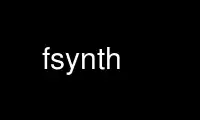
This is the command fsynth that can be run in the OnWorks free hosting provider using one of our multiple free online workstations such as Ubuntu Online, Fedora Online, Windows online emulator or MAC OS online emulator
PROGRAM:
NAME
siggen - an Ncurses based signal generator program
SYNOPSIS
siggen [-s samplerate] [-8|-16|-b 8|-b 16] [-1|-2]
DESCRIPTION
siggen is a simple signal generator program, with an Ncurses based user interface, that
can digitally generate standard waveforms on the LINUX /dev/dsp device. 8 or 16 bit
samples can be generated depending on the hardware.
siggen allows two independent waveforms to be generated. In stereo the two signals appear
on different channels. In mono the two signals are digitally mixed onto the one mono
channel.
The frequency is specified as an integer number of Hertz. Fractional Hertz frequencies are
not supported. Of course, only frequencies less than half the samplerate (number of
samples/sec) are accurately meaningful. Higher frequencies can be specified, but don't
expect to hear them!
The waveforms that can be generated are:
sine A standard sine wave
cosine a sine wave with a 90 degree phase shift
square a standard square wave with a 50% mark space ratio
triangle
a ramp waveform with 'infinitely' fast flyback (:-) An ideal oscilloscope timebase
signal.
sawtooth
shaped like equally spaced teeth on a saw (:-)
noise This is weak. All it consists of is one second of pseudo-randomly generated
samples, played repeatedly. I'd love to do proper white/pink noise, but I don't
know enough, and I don't think the structure of the program is conducive to
accurate noise generation.
pulse A square waveform where the mark/space ratio (as a percentage) can be specified.
The default value is 10% (mark/space ratio of 1:9).
A lot of thought has gone into the algorithms for generating the waveforms. I believe the
sin/cos wave to be very pure (modulo your sound card :-), but I don't have access to a THD
meter to measure it. For best signal accuracy leave the gain setting at 100(%). The
generator will then make the wave's peak value fit the maximum digital values allowed. Use
a mixer program to control the output volume, or an external attenuator.
The gain factor option can be useful for simulating a signal that has been subject to
clipping, by specifying a gain of > 100%. In fact a trapezoid signal can be made by
generating a clipped sawtooth wave. The greater the gain, the closer the signal approaches
a square wave (the rise and fall times decrease).
siggen generates one seconds worth of 1 Hz samples at the specified samplerate, for each
waveform, and generates frequency F by circularly sampling every Fth sample. Each buffer
fragment is generated for the parameter(s) set at that moment. Buffer fragment sizes are
set so that aprox. 10 fragments/sec are generated. Changing a generation parameter, e.g.
waveform, frequency, gain, will impact the next buffer fragment generated, and hence
changes appear to be almost immediate.
If your sounds periodically 'breaks' up with clicks or breaks, it is usually a sign that
siggen is not being scheduled sufficiently often. Either up the priority (see nice et
al.), kill off other processes, get a faster processor, or increase the number of audio
buffer fragments that siggen uses. This last will make siggen respond more sluggishly to
changes in generation parameters. syslogd and crond are two processes that I've found
useful to kill off - YMMV.
Defaults
output to /dev/dsp, 22050 samples/sec, stereo if stereo card else mono, 16 bit
samples if possible, else 8 bit, 3 audio buffer fragments.
OPTIONS
-h display usage and help info
-v be verbose
-s samples
generate with samplerate of samples/sec
-8|-16 or -b 8|16
force 8 bit or 16 bit mode.
-1|-2 mono or stereo
EXAMPLES
Use fsynth online using onworks.net services
